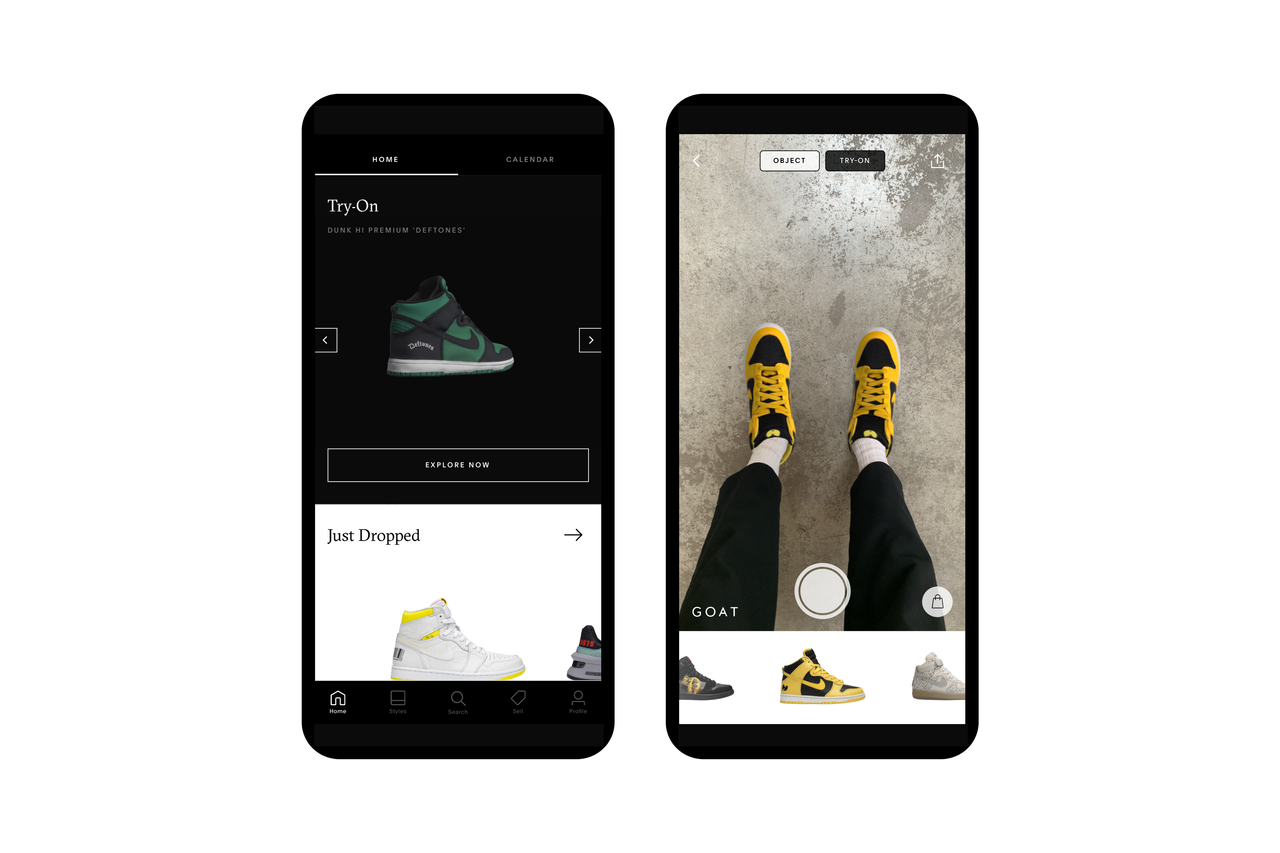FOR A BRIEF MOMENT, Jerry Lu’s friends thought he had scored an advance pair of the most sought-after sneakers of the year. In December, Mr. Lu, 28, a venture capital investor in New York City, tweeted out a photo showing
Nike’s
Dior edition Air Jordan 1 sneakers perched on his floor. “How much did you pay?” one follower asked. “Nice!!!” replied another. The shoes certainly warranted three exclamation points—In addition to looking cool, they hadn’t been officially released yet. And yet there they were on his floor. Only they weren’t really: Mr. Lu’s shoes were 100% digital.
He generated them using Goat, a sneaker reselling app. The app (available for iPhones and Android phones) boasts an augmented reality feature that allows sneaker fans to digitally try on rare shoes. With the app open, users tilt their phones downward and like magic, Nike Dunks or Air Jordans appear on their feet. The technology was developed by Wannaby, a Belarusian tech-start-up that has also recently licensed its cyber-sneaker tech to Gucci and Farfetch China. These aren’t the only companies toying with AR footwear. Last year, Nike added an AR foot-size measuring feature to its phone app and the Adidas app also includes an AR try-on for a small crop of its running shoes.
The Wannaby technology is the most refined of the bunch. When I tried the Adidas app, the recreated sneakers vibrated, exposing my socks underneath. Yet, when using both the Goat app and Wannaby’s own Wanna Kicks app, my shoes came out crisp and complete. I took a screenshot of myself “wearing” Nike’s Air Ship sneakers (another model that has not come out yet) via the Goat App and texted it to a sneaker-savvy friend. “Whattttt,” he replied, not quite convinced, but also not entirely dubious.
The secret to the app’s success, as Sergey Arkhangelskiy, Wannaby’s CEO, explained, is that the company builds the digital sneaker from 100 to 150 photographs of the physical shoe from different angles. “If you try to build a model using only references, it never ends up with the sneakers [being] believable,” said Mr. Arkhangelskiy. In a true scrappy start-up move, the company purchases Nike, Adidas and Puma sneakers from stores, photographs them for the Wanna Kicks site, and then returns them.
Wannaby originally started with Wanna Nails, an app that allowed users to try on different patterns of finger nail polish, yet it soon realized “that the nail polishes market is not that great.” In summer of 2018, Wannaby shifted towards sneakers, which had both a sizable market and serious potential for social media shareability.
Wanna Kicks’s focus is largely on shoes that are common and affordable, like the $150 Nike Air Max 270 React, or Allbirds’s $95 Tree Runners. Wanna Kicks’s selection includes mass-market shoes that are readily available, both because they’re easy to procure (and photograph) and the customer will instantly recognize the sneakers. Despite this approachability, according to Mr. Arkhangelskiy, a majority of users are not taking advantage of the app’s AR experience to influence their purchases. “Most of the excitement is to just see new sneakers, cool sneakers, share them through social networks and show to friends,” said Mr. Arkhangelskiy. The novelty of digital sneakers seems to apply to even relatively inexpensive models. Wanna Kicks generates its revenue not from “affiliate links,” which kick back a percentage of a sale that was initiated through the app, but from licensing its AR technology to other companies.
On Goat, some of the AR-ified sneakers are not even available for purchase. The app gives “people access to shoes that they might not normally be able to access,” said Eddy Lu (no relation to Jerry Lu) Goat’s CEO. Though Goat has 75,000 different products, its AR tech is available for just 16 bogglingly rare shoes, which stoke excitement and often misguided envy on social media.

When you try on a pair of shoes through the app, the clickable option that follows is not “Buy Now” but “Share and Save.” Akshay Pall, 21, a student in New York, did just that. He screenshotted a photo of himself “wearing” sneakers from the app and sent it to friends, imploring them to download the app as well. For Mr. Pall, the app allows him to imagine a world in which he can actually afford a $2,000 pair of sneakers. “A lot of the sneakers they have on the display are some of the more sought after ones. Being a student it’s questionable if I can spend that much money on a pair of shoes,” he said.
AR does convert to sales occasionally—78% of users that bought Nike’s Travis Scott sneaker played around with the AR version on Goat first—but by and large sales are secondary for now. Goat is playing the “long game” said Mr. Lu, hoping that the users who download the app to digitally flaunt the “Fragment Design” Air Jordan 3 sample (a model that was never even released), will also use it to buy actual sneakers down the line.
Some shoppers are hungry for more widespread AR tech. The investor Mr. Lu noted that before he makes a sneaker purchase, he always Googles image-searches actual photographs of that specific sneaker “on feet” to scrutinize what a shoe looks like when worn with specific pants or a given outfit. More sophisticated AR would allow him to achieve that on his own feet and body. Until then, he’ll enjoy his pixelated kicks.
Write to Jacob Gallagher at Jacob.Gallagher@wsj.com
Copyright ©2019 Dow Jones & Company, Inc. All Rights Reserved. 87990cbe856818d5eddac44c7b1cdeb8